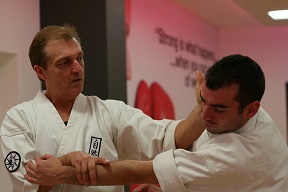What is Karate?
Adult advanced training methods
What is Karate?
Karate translated means empty hand. Shi Zen Do Karate system is based on traditional Wado Ryu, founded by Hironori Ohtsuka and Go Ju Ryu Karate, founded by Chojun Miyagi, which has at its core traditional Okinawan and Japanese martial arts traditions. Shizendo also employs the Chinese concepts and principles and integrates these methods of training to enhance our empty hand art. With this approach historically turning back the hands of time, giving us a unique approach to the Martial Arts prospective whilst developing the Karate to a greater understanding. Roots and branches approaches a history of martial arts within the Shizendo training syllabus.
The Wado Ryu badge, depicting the dove of peace and the fist, encompasses the idea of this system. The dove symbolizes all that is associated with peace and harmony. The fist indicates that to keep this balance a strong grasp is needed; to find inner peace and a strong spirit you first need to train the physical part of the self first. A strong fist is of no use if the Karateka has no control over their emotional and spiritual state of being. It is vital that a balance can be reached between these two. The circular shape of the badge reinforces that this is a soft style, and reflects that the movements in Wado tend to be more circular than other Karate styles. It also reminds us that training is an everlasting cycle of improvement.
At the heart of the Karate system are the Katas, which are pre-arranged forms. The physical aims of Kata training are to strengthen bone, muscle and ligament and to maximize the efficiency of one’s biomechanics. This helps develop fast reflexes and movements, increasing the ability to respond quickly through all of the body’s natural range of movements. The four Katas (pre-arranged forms) are the four jewels in the crown of the Wado Ryu system and are as follows: Naihanchi, Kushanku, Seishan, Chinto and Go Ju Ryu Sanshin and Tensho.
Kata originally were teaching and training methods by which successful combat techniques were preserved and passed on. The basic goal of kata is to preserve and transmit proven techniques and to practice self-defence. By practising in a repetitive manner, the learner develops the ability to execute those techniques and movements in a natural, reflex-like manner.
“Tradition should inspire innovation not limit it”
The Chinese systems (Wing Chun – Tai Chi Chuan) use sticky hands training or Chi Sau. Karate makes use of “Kake Uke which is sticky hands” or Entangling Hands. These training methods are used to cultivate sensitivity and receptivity through touch enabling the student to respond in close quarter fighting. Kake is soft; Juken is the art of sensitivity and receptivity, once felt the explosive power of the strike is released and focused to a point of contact onto the opponent, kimae.
Shizendo Karate training methods also employ this idea in the form of Kake and Tegumi Tegumi. Tegumi – Kake are prearranged hand drills worked in pairs, this part of our training develops the students skills of touch reflex. It is from here that the secrets of the Karate Katas are unlocked with the key of Tegumi – Kake. This leads into Karate’s close range freestyle sparring. The basic four arm techniques (the so called “blocks”) found in all Karate styles are the upper, lower, inner and outer uke (uke means “to receive”) movements; these four techniques make up the hand drills in the system. Every Karate Kata bunkai (application) can be fed through at this important range: punches, kicks, locks, throws, takedowns, etc. This is the true Kata range. This is where the Karateka uses the techniques learnt in Kata and fed through to the hand drills, thus developing their knowlege and application for self-defence, the use of correct distance, developing the stickiness and the cultivated power generation through partnered drills. Learning and developing the hand drills is the most important training concept a Karateka will take towards understanding Shizendo karate.
Karate is the art of controlling, or defending one’s self from an opponent through the use of manipulation of the joints (Kensetsu) and grappling (Tuite) and impact (striking). Tegumi combined with Tuite and Kensetsu offers an inexhaustible variety of possible reactions to any given attack, taken from the principles and concepts learnt from the Katas. The application to Kata offers only an idea of its usage; what’s more important are the principles and concepts behind the idea.
Tegumi – Kake training over time will develop the student to a level of “on the spot” application, where the student can flow from one idea (response) to another whilst controlling his opponent through mulipulation and impact.
Tegumi – Kake training promotes in the student the ability to flow. The flow is the most important point of training because without the flow there cannot be changes. Changes are the ability to react and respond to an almost inexhaustible variety of methods of attack. Therefore flow is the art and without the flow there is no art.
Tegumi ——— Flowing hands
Tuite ————- Grasping hands
Kensetsu —— Joint locking hands
Kake ————- Sticky hands
Shi Zen Do means “Natural relaxed” or “Natures Way”, an encompassing term in which a person remains naturally relaxed but alert. This is reflected both physically and mentally thus developing a strong spirit. All movements are subject to the laws of nature. The word “Do”, when used as a suffix to a particular style of Japanese Martial Arts, is indicative of more than just a means of combat. “Do” indicates a discipline and philosophy with moral and spiritual connotations, the ultimate aim being enlightenment through personal development.




